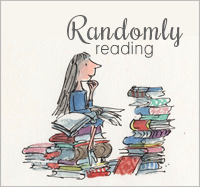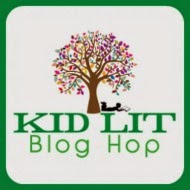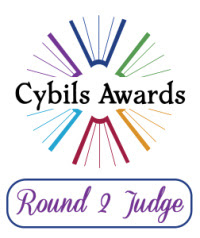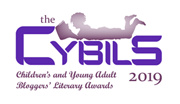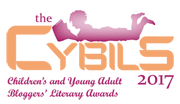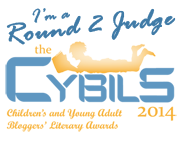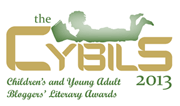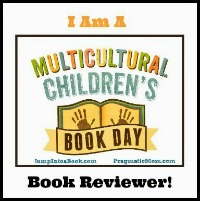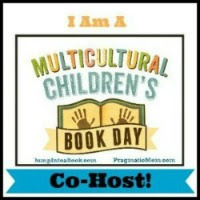It's Monday! What are you reading? is the original weekly meme hosted by Sheila at Book Journey. It's Monday! What are you reading? - from Picture Books to YA is a kidlit focused meme just like the original and is hosted weekly by Teach Mentor Texts. The purpose is the same: to recap what you have read and/or reviewed and to plan out your reading and reviews for the upcoming week.
First, I apologize for doing so many roundups lately. December is a busy month for me, but it's also Christmas, and so here are some old and new favorites that I have been reading this week.
Eight Jolly Reindeer by Ilanit Oliver, illustrated by Jacqueline Rogers
Scholastic, 2014 16 pages
In this rhyming board book, young readers can count Santa's eight reindeer one by one and by name as each jumps ups in happy anticipation of the arrival of Christmas. This is a nicely shaped book and there is a shiny glittery tab for each of the eight reindeer. In the end, they are all hitched to Santa's sleigh, ready for the big night ahead. Age 2+
Little Blue Truck's Christmas by Alice Schertle, illustrated by Jill McElmurry
Houghton Mifflin Harcourt, 2014, 24 pages
Another counting, rhyming board book for young readers that continues Little Blue Truck's adventures. It's Christmas and Little Blue Truck has 5 Christmas trees, count them 1, 2, 3, 4, 5. Now he need to deliver them all over town to his friends. And when he is finally done, there is a twinkly surprise waiting for him at home. Age 3+
Here Comes Santa Cat by Deborah Underwood, illustrated by Claudia Rueda
Dial Books, 2014, 88 pages
Remember Cat from Here Comes the Easter Cat? Well, Cat's back. It's December 24th and Cat is pretty sure he is on Santa's naughty list, which means no presents for him. Is it too late to be nice enough to get off the naughty list and on to the nice list so Santa will pay Cat a visit on Christmas Eve? This is a great laugh out loud read aloud for parents, teachers and young readers who will certainly understand the humor of Cat's dilemma. Ages 3+
A Charlie Brown Christmas Pop-Up Edition by Charles M. Schulz
Running Press, 2010, 10 pages
There are lots of versions of this Christmas classic, but since I love paper engineering, this pop-up version is my favorite. Each page has a large pop-up surrounded by the story's text and there are large flaps on some of the pages that reveal even more pop-ups when opened. As you can see, the whole Peanuts gang is included. Ages 4+
The Christmas Magic by Lauren Thompson, illustrated by Jon J. Muth
Scholastic, 2009, 40 pages
When Santa's whiskers begin to tingle, he knows it is time to start getting ready Christmas. Brushing and feeding his reindeer, trimming his own whiskers, polishing his sleigh bells, darning his thick woolen winter socks, and, oh yes, getting toys ready for kids all around the world. It's a lot to do, but Santa is definitely the man for the job. The gentle watercolor and pastel illustrations are a perfect compliment to the poetic language of this beautiful book that is sure to become a holiday classic. Ages 4+
The Christmas Coat: Memories of My Sioux Childhood
by Virginia Driving Hawk Sneve, illustrated by Ellen Beier
Holiday House, 2011, 32 pages
The winters on the South Dakota prairie are cold, windy and snowy. Young Virginia has outgrown the coat she has and needs a new on. The daughter of an Episcopal priest, she knows that when the boxes from the East arrive full of donated clothes, she will have to wait until everyone else on the Rosebud Sioux Reservation takes what they also need. But when her best friend gets the fur coat Virginia was hoping for, it's back to her old outgrown coat. Will Christmas bring a welcomed surprise for Virginia? This picture book for older readers is a beautifully recounted memory from the author's childhood and complimented by the watercolor and gouache realistically detailed illustrations. Ages 5+
Junie B., First Grader
Jingle Bells, Batman Smells (P.S. So Does May)
by Barbara Park, illustrated by Denise Brunkus
Random House, 2005, 128 pages
It's the last week of school before the Christmas break and Room One is getting ready to celebrate. There's a holiday sing-along, complete with elf costumes in the auditorium, then there's picking name's for the class Secret Santa gift giving and to make that easy, the school is hosting a gift shop for the kids. But, uh oh, Junie B.'s secret Santa pick is her nemesis May. That's bad, but when Junie sees the only Squeez-A-Burp at the gift shop, she knows she can't get that for May, because she wants it herself. Can you guess how Junie's dilemma is resolved? Typical Junie, but a nice chapter book for young readers, because, as always, there's a lesson to be learned. Ages 7+
A Christmas Treasury
Dover Publications, 2014, 96 pages
If you are in the mood for some old fashioned Christmas stories, this anthology is just the ticket. The six fully illustrated tales include The Night Before Christmas by Clement C. Moore (1917), Father Christmas by Clifton Bingham (1920), How Santa Filled the Christmas Stockings by Carilyn S. Hodgman (1916), A Visit to Santa Claus by Margaret Evans Price (1917), Polar Bear at the Zoo by Helen C. Dods (1917), and Christmas ABC (1910). Young readers will probably recognize The Night Before Christmas, but the others hold some enchantment for them as well. Kids will enjoy seeing that Christmas concerns, such as will Santa bring Tommy the same amount of presents in his stocking as he brings his older siblings with bigger stockings, were as common then as they are now. This book certainly is a treasure. Ages 5+
The Night Before Christmas: A Classic Illustrated Edition by Clement C. Moore
Chronicle Books, 2005, 44 pages
When my old hand-me-down Little Golden Book of this Christmas favorite finally fell completely apart, I replaced it with this beautifully illustrated version. This has always been my favorite Christmas poem so I was kind of picky when it came time for a new one. I chose this one because I liked the illustrations which come from a number of different sources, yet they all work together so well. Do you have a favorite version of The Night Before Christmas?
Everything I Need to Know About Christmas,
I Learned from a Little Goden Book by Diane Muldrow
Random House, 2014, 96 pages
Speaking of Little Golden Books, here is one that is sure to tickle your funny bone and warm your heart. All your old favorites are included here. The nostalgic illustrations are all reprints from different Little Golden Book stories paired with words of wisdom, guidance and reminders of things to do to get ready for the big Christmas celebration. I think this is more a book for adults who need to take a breather from holiday hustle and bustle and go for a walk down the Little Golden memory lane. Yes, that is the Pokey Little Puppy in Santa's bag on the cover. Ages 12+
Here is what I am looking forward to reading this week:
Bombay Blues by Tanuja Desai Hidier
This is the sequel to
Born Confused
What are you reading this week?
























































